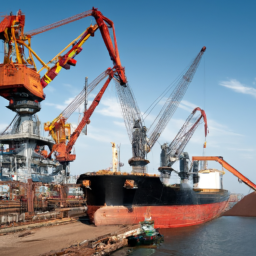In recent developments, China has imposed a ban on all iron ore cargoes from BHP, a significant player in the global mining industry and the worlds largest listed miner. This decision marks a notable escalation in a pricing dispute that has implications not only for BHP but also for the broader iron ore market, given Chinas position as the largest consumer of iron ore worldwide. Chinas dominance in the iron ore market is substantial, accounting for approximately 75 percent of global seaborne iron ore imports. This statistic underscores the importance of Chinese demand in determining global iron ore prices and the economic health of mining companies like BHP. The ban comes amid ongoing tensions between BHP and Chinese steelmakers, who are increasingly vocal about their dissatisfaction with the pricing strategies employed by major iron ore suppliers. The crux of the dispute appears to center around pricing mechanisms. BHP, along with other major producers, has been transitioning towards a pricing model that is more reflective of market conditions, which has not been well-received by Chinese importers. As observed, Chinese steelmakers have expressed concerns that the new pricing strategies could lead to higher costs for raw materials, impacting their profit margins and competitiveness in the global market. In my experience analyzing commodity markets, such disputes often arise when there is a significant imbalance between supply and demand dynamics. Currently, the global iron ore market is experiencing fluctuations due to various factors, including geopolitical tensions, environmental regulations, and shifts in production levels. Industry experts note that these factors contribute to a complex pricing environment that can lead to friction between suppliers and consumers. The implications of this ban are far-reaching. For BHP, the loss of access to the Chinese market could result in substantial financial repercussions. According to industry analysts, China represents a significant portion of BHPs revenue, and the inability to export iron ore to this key market could lead to a decline in profits. Furthermore, this situation raises questions about BHPs pricing strategy and its ability to navigate the complexities of international trade relations. On the other hand, the ban could also have a ripple effect on the Chinese steel industry. As the largest consumer of iron ore, any disruption in supply could lead to increased prices for steel production, which could ultimately be passed on to consumers. This scenario could exacerbate existing inflationary pressures within the Chinese economy, particularly in the construction and manufacturing sectors, which are heavily reliant on steel. Research confirms that trade disputes of this nature can lead to longer-term shifts in market dynamics. For instance, if BHP is unable to resolve the pricing dispute with Chinese steelmakers, it may seek to diversify its customer base by increasing exports to other countries. This shift could alter the competitive landscape of the iron ore market, potentially benefiting other producers who are willing to meet the pricing expectations of Chinese buyers. Moreover, the ban raises questions about the future of iron ore pricing mechanisms. Experts agree that a more collaborative approach between suppliers and consumers may be necessary to avoid similar disputes in the future. Establishing a pricing model that reflects the realities of the market while also considering the needs of consumers could foster a more stable trading environment. As the situation develops, it is essential to monitor the responses from both BHP and Chinese steelmakers. Industry insiders suggest that negotiations may take place in an attempt to resolve the pricing dispute, as both parties have a vested interest in maintaining a robust trading relationship. However, the outcome of these negotiations remains uncertain, and the potential for further escalation cannot be ruled out. In conclusion, the ban on BHP iron ore cargoes by China signifies a critical juncture in the ongoing pricing dispute between major iron ore producers and Chinese steelmakers. The implications of this decision extend beyond immediate financial impacts, potentially reshaping the dynamics of the global iron ore market. As both parties navigate this complex landscape, the need for transparent communication and collaborative pricing strategies will be paramount in fostering a sustainable trading environment. The future of iron ore pricing may hinge on the ability of BHP and Chinese steelmakers to find common ground in an increasingly competitive and volatile market.
TRENDING NOW
WORLD
Global Messaging Trends: Can Local Apps Like Arattai Overtake Giants?
44% 🔥
POLITICS
Accusations fly over whether Republicans or Democrats 'own' shutdown
35% 🔥
POLITICS
Rep. Mike Haridopolos, R-Fla., talks about the government shutdown
34% 🔥
POLITICS
What happens now that the government has shut down. And, a pricing deal with Pfi...
26% 🔥
POLITICS
Married, but no connection: Reality of silent divorces in Indian homes
31% 🔥
POLITICS
Netanyahu's apology to Qatar, phone on Trump's lap: A telling White House photo
38% 🔥
MOST READ
SPORTS
Week 5 NFL odds, lines, betting picks, spreads: 2025 predictions: Model backs Sa...
55% 🔥
SPORTS
Predicting every undefeated college football team's first loss: Will anyone beat...
36% 🔥
SPORTS
Tigers Lefty Tarik Skubal Deserves Second Straight AL Cy Young Award
54% 🔥
SPORTS
Jets Get Official Braelon Allen Injury Diagnosis
61% 🔥
SPORTS
Gill: India won't be 'looking for any easy options' against West Indies
49% 🔥
SPORTS
Phil Mickelson takes a jibe at golf during friendly banter with ex-LIV Golf CEO’...
39% 🔥

